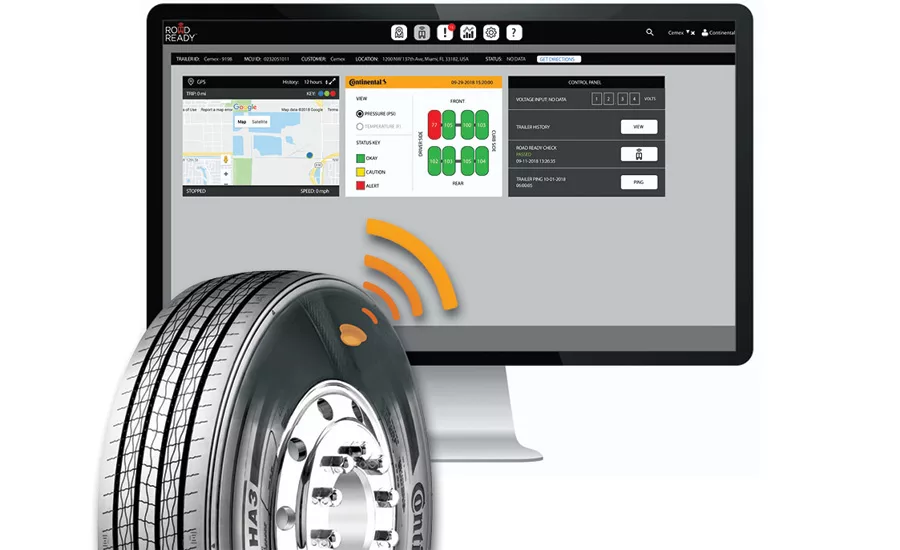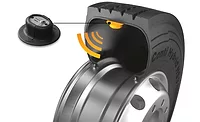The 2019 beverage delivery tire guide
The latest releases from Michelin, Continental, Bridgestone and Hankook

Continental recently announced that it has integrated its ContiPressureCheck tire pressure monitoring system with the Road Ready trailer telematics system by Truck-Lite Co. (Image courtesy of Continental)
Tire technology continues to evolve to keep up with the ever-changing needs of the modern beverage delivery fleet, with an eye on fuel efficiency, improving tread life and integrating with the latest advances in on-board systems for a much more intelligent ride.
A number of the industry’s leading tire suppliers have unveiled a range of new products, as well as technical enhancements to existing models to improve the performance of beverage distributors traversing a vast range of terrain, miles and conditions. Here’s a quick glimpse at where the rubber hits the road:
Michelin
Earlier this year, Michelin North America launched the new Michelin Agilis CrossClimate tire for commercial fleets. Designed primarily for smaller delivery fleet and merchandising vehicles, like vans and pickups, the tire is available for lighter-duty commercial vehicles such as Ford Transit, Ram ProMaster and Nissan NV200. The Agilis CrossClimate, offers durability over extended mileage, improved protection from impacts, punctures and aggressions and all-weather/all-season performance for year-round rough conditions, the company says.
The tire features a number of engineering innovations:
- MaxPressure Profile optimizes the tire footprint for better wear life under high pressure, heavy loads, high torque and stop-and-go driving. The StabiliBlok design provides wider and longer tread blocks that resist extreme torque while providing relatively cooler operating temperatures under full loads at high speeds.
- SipeLock provides hundreds of biting edges for improved wet and snow traction without sacrificing tread-block stability.
- CurbGard sidewall protectors resist curb scrubbing in urban environments. The tire has more than twice as much nylon reinforcement as the Michelin LTX M/S for improved sidewall strength and durability.
Continental
Continental recently announced that it has integrated its ContiPressureCheck tire pressure monitoring system with the Road Ready trailer telematics system by Truck-Lite Co. By using ContiPressureCheck with Road Ready’s telematics, fleets can improve safety, reduce roadside service calls, extend tire life and reduce tire maintenance costs, Continental says. Road Ready’s SmartBridge Integrator now broadcasts data from ContiPressureCheck to the cloud, where it is visible on the Road Ready user interface. This enables seamless integration of tire pressure and temperature data into the trailer telematics dashboard.
Continental also recently renamed its long haul tire for improved clarity. The new name spells out the vehicle classification, axle configuration and application for which the tire was designed. The Conti HSL 3 is a heavy truck tire, designed for steer and all-position use in long-haul and super-regional applications. The tire’s former name was Conti Hybrid HS3.
Bridgestone
This past spring, Bridgestone Americas launched the Bridgestone R284 Ecopia tire, a SmartWay-verified steer tire designed for improved fuel economy and enhanced treadwear. The tire is equipped with patented NanoPro-Tech polymer technology for a 5 percent improvement in rolling resistance, compared with the Ecopia R283A steer tire, it says.
Bridgestone representatives explain that when tires are in operation, gravitational forces create drag between the tire and the pavement. This causes rolling resistance, the energy a vehicle sends to the tires to maintain movement at a constant speed, which results in energy or fuel loss. Tires designed for low-rolling resistance contribute to a vehicle’s overall fuel economy.
Hankook Tire
Hankook’s Smart Flex AH35 all-season tire, designed for variable road conditions, features a special tread design and multi 3-D sipes to provide high mileage and enhanced traction performance across those different surface conditions. A combination of four wavy and straight grooves within the tread provide optimal traction and drainage on regional delivery, as well as long-haul applications. The tread pattern design with semi-sipes ensures even wear throughout the tire’s lifespan. The belt structure is designed for minimal motion to help reduce heat generation.
Additionally there’s an optimized carcass structure designed for better ride and handling, as well as an enhanced bead profile for maximum retreadability. The tire’s signature wide tread width versus conventional tires used in the same applications offers high pattern volume, which in turn, could improve mileage performance, according to the company. BI
Looking for a reprint of this article?
From high-res PDFs to custom plaques, order your copy today!





